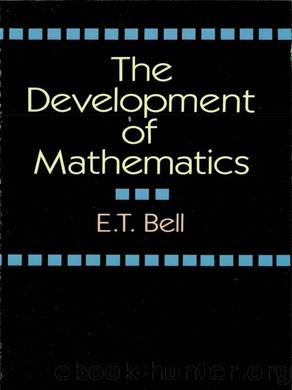Development of Mathematics by Bell E. T.;

Author:Bell, E. T.;
Language: eng
Format: epub
ISBN: 1909757
Publisher: Dover Publications
Published: 2012-10-10T16:00:00+00:00
CHAPTER 15
Contributions from Geometry
With a literature much vaster than those of algebra and arithmetic combined, and at least as extensive as that of analysis, geometry is a richer treasure house of more interesting and half-forgotten things, which a hurried generation has no leisure to enjoy, than any other division of mathematics. Continually changing ideals and objectives in the development of geometry since the seventeenth century have made it impossible for students and working mathematicians to be aware of hundreds of theorems, and even extensive theories, that the geometers of the late nineteenth century prized as objects of rare beauty.
On a rather humble level, for example, it was held by competent geometers in 1940 to be a sheer waste of effort for a student contemplating a career in geometry, or in any division of living science or mathematics, even to glance at the so-called modern geometry of the triangle and the circle, created largely since 1870. Yet it has been said, no doubt justly, that almost any theorem of this intricate and minutely detailed subject would have delighted the ancient Greeks. And that, precisely, is the point. All the classic Greek geometers were buried or cremated two thousand years ago. Geometry in the meantime has advanced. By 1900 at the latest, special theorems in Euclidean geometry were no longer even a tertiary objective of creative geometers, no matter how beautiful or how interesting they might appear to their authors.
This does not imply that such theorems were valueless to those who could appreciate them; they preserved more than one isolated teacher from premature fossilization. They may also have irritated some who later became skilled geometers into finding out what modern geometry is about. On the other hand, many a working mathematician of the 1930’s looked back with something akin to rage in his heart on the months or years squandered on this sort of geometry, or on the interminable properties of conics, at the very time of his life when his capacity for learning was greatest and when he might have been mastering some living mathematics.
In defense of this waste, if such it were, it was argued that English schoolboys still took a keen pleasure in these intriguing puzzles of their forefathers. No doubt they did. But the further claim that such a training made first-rate geometers is contradicted by the evidence. The attempted justification on the grounds of mental discipline may be left to the psychologists. In any event, it seemed slightly fatuous to impart discipline through outmoded fashions when so much of equal difficulty and vital necessity had to be mastered if one were to think geometrically in the manner demanded by a continually advancing science and mathematics. The foregoing opinions, it may be stated, were those of three of England’s foremost mathematicians in the 1930’s, all of whom had made high marks in this prehistoric sort of geometry in competitive examinations for English university scholarships.
However, even in the most elementary geometry an original and ingenious mind may occasionally think of something to do rather unlike what is already classical.
Download
This site does not store any files on its server. We only index and link to content provided by other sites. Please contact the content providers to delete copyright contents if any and email us, we'll remove relevant links or contents immediately.
| Applied | Geometry & Topology |
| History | Infinity |
| Mathematical Analysis | Matrices |
| Number Systems | Popular & Elementary |
| Pure Mathematics | Reference |
| Research | Study & Teaching |
| Transformations | Trigonometry |
Modelling of Convective Heat and Mass Transfer in Rotating Flows by Igor V. Shevchuk(6200)
Weapons of Math Destruction by Cathy O'Neil(5778)
Factfulness: Ten Reasons We're Wrong About the World – and Why Things Are Better Than You Think by Hans Rosling(4454)
Descartes' Error by Antonio Damasio(3138)
A Mind For Numbers: How to Excel at Math and Science (Even If You Flunked Algebra) by Barbara Oakley(3075)
Factfulness_Ten Reasons We're Wrong About the World_and Why Things Are Better Than You Think by Hans Rosling(3025)
TCP IP by Todd Lammle(2982)
Applied Predictive Modeling by Max Kuhn & Kjell Johnson(2857)
Fooled by Randomness: The Hidden Role of Chance in Life and in the Markets by Nassim Nicholas Taleb(2833)
The Tyranny of Metrics by Jerry Z. Muller(2818)
The Book of Numbers by Peter Bentley(2744)
The Great Unknown by Marcus du Sautoy(2516)
Once Upon an Algorithm by Martin Erwig(2456)
Easy Algebra Step-by-Step by Sandra Luna McCune(2433)
Lady Luck by Kristen Ashley(2386)
Practical Guide To Principal Component Methods in R (Multivariate Analysis Book 2) by Alboukadel Kassambara(2358)
Police Exams Prep 2018-2019 by Kaplan Test Prep(2332)
All Things Reconsidered by Bill Thompson III(2241)
Linear Time-Invariant Systems, Behaviors and Modules by Ulrich Oberst & Martin Scheicher & Ingrid Scheicher(2210)
